
The double-striped pug is a moth of the family Geometridae. It is a widespread and common species, being found throughout the Palearctic region, including the Near East and North Africa.
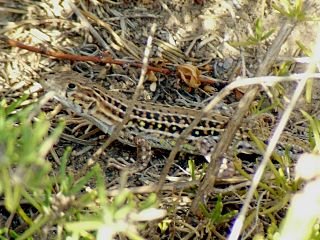
Acanthodactylus erythrurus, commonly known as the spiny-footed lizard, is a species of lizard in the family Lacertidae. The species is endemic to northwestern Africa and the Iberian Peninsula. It is considered to be the fastest member of the family Lacertidae. Its common name refers to the spines that are arranged like a comb on the toes of its hind legs.

The Asilidae are the robber fly family, also called assassin flies. They are powerfully built, bristly flies with a short, stout proboscis enclosing the sharp, sucking hypopharynx. The name "robber flies" reflects their expert predatory habits; they feed mainly or exclusively on other insects and, as a rule, they wait in ambush and catch their prey in flight.

The Lauxanioidea are a superfamily of flies that includes the two large families, the Lauxaniidae and Chamaemyiidae, and the small family Celyphidae. Generally, they are small to medium, densely populated, coloured flies. The Chamaemyiidae live as parasites on insects. The family Celyphidae look like beetles.

Volucella zonaria, the hornet mimic hoverfly, is a species of hoverfly. These flies are capable of buzz pollination.

Blepharotes coriarius, the giant yellow robber fly, is a species of large predatory fly from Australia in the family Asilidae. It was described by the German naturalist Christian Rudolph Wilhelm Wiedemann in 1830.

Dioctria atricapilla, the violet black-legged robber fly, is a species of robber fly in the subfamily Dasypogoninae. This 9- to 12-millimeter long insect has a wingspan of roughly 7 to 9 mm and short, three-segmented antennae. It's a predatory insect, feeding mainly on smaller flies and predatory hymenopterans. It primarily thrives in grassland, and is seen from May to July.

Laphria is a genus described by Johann Wilhelm Meigen in 1803, belonging to the family Asilidae, subfamily Laphriinae. Members of this genus are known as bee-like robber flies. This genus has a Holarctic distribution, occurring in Europe, Asia, and North America. They prey on a variety of insects, including other robber flies, bees, wasps and beetles. Like other asilids, they use their proboscis to penetrate the body of their prey and inject enzymes which dissolve the tissues.

Choerades is a genus of robber flies described by Francis Walker in 1851, belonging to the family Asilidae, subfamily Laphriinae.
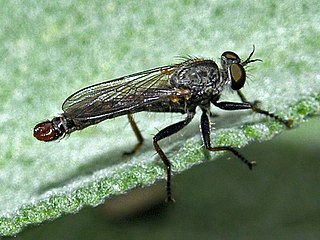
Cerdistus is a genus of robber flies in the subfamily Asilinae.
Cerdistus elegans is a species of robber flies in the subfamily Asilinae. It is found in Tunisia.
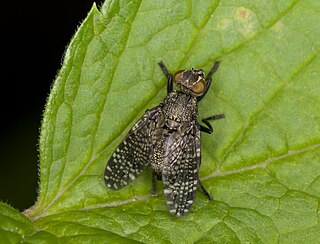
Platystoma seminationis, the dancing "kiss fly", is a species of fly in the family Platystomatidae.
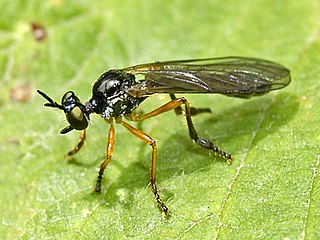
Dioctria bicincta is a species of robber fly classified in the subfamily Dasypogoninae of the family Asilidae.
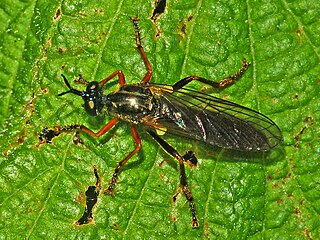
Dioctria rufipes, the common red-legged robberfly, is a species of robber fly in the subfamily Dasypogoninae of the family Asilidae.

Cyrtopogon ruficornis is a species of fly in the robber flies family. It is found in parts of Central and Southern Europe.

Machimus setibarbus is a species of fly in the family Asilidae, the robber flies and assassin flies.

Neomochtherus geniculatus is a species of fly in the robber fly family, Asilidae.

Choerades marginata is a species of robber fly found in Europe.
Mallophora ruficauda is a species of parasitic robber fly in the family Asilidae, endemic to South and Central America. Like other robber flies, M. rauficauda is known for its aggressive behavior and predation upon other insects, especially bees. M. ruficauda mimics a bumblebee to fool predators into thinking it has a painful sting and is not worth eating.

The tucan fish, also called the yellowfin chalceus, is a species of freshwater fish in the family Chalceidae. It is one of five species in the genus Chalceus, and was the second species to be described therein.


















